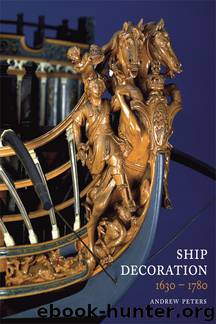Ship Decoration: 1630-1780 by Andy

Author:Andy
Language: eng
Format: epub
Tags: Bisac Code 1: TRA006010; TRANSPORTATION / Ships & Shipbuilding / History
ISBN: 9781848323322
Publisher: Seaforth Publishing
Published: 2013-10-23T04:00:00+00:00
Details of carved work on the Annapolis Britannia model: poop bulkhead; royal arms on the quarterdeck stern rail; beakhead bulkhead carvings. (By courtesy of Grant Walker)
Two male portraits are placed near the base of the quarter pieces. These would presumably have been changed from Charles II to William (Mary having died in 1694) and are decorated with palms rather than acanthus. The central panel to the stern gallery of the upper deck has a similar motif of leaves, here depicted as waving reeds, with a central cartouche displaying Admiralty insignia. Nymph-like figures swim amid the reeds, with mythical beasts that extend the composition onto the quarters, in a further attempt to stress the horizontal nature of the design. Such aquatic scenes are common on the ships of William and Mary, but the reeds are rarely depicted with such confident naturalism. A similar panel with a male portrait as its centrepiece is replicated between the rails of the poop deck bulkhead.
Palms are very much an innovation taken from French ships rather than of Dutch or English origin and point to Mary’s admiration of the French Baroque. She was instrumental in the employment of Huguenot craftsmen in the alterations to Hampton Court, where similar motifs are found. They also appear on the stern of her shallop of 1689. Palms first appear as an alternative motif to acanthus on British ships around 1700. As is so often the case, fashions acceptable within high society take a while to filter down to general use, and even then in a more moderate form. The confident use of the motif on Britannia is accentuated by cutting them clear of the background, a feature they share with the acanthus panel and tafferel figures, helping to create a cohesive quality to the various decorative elements of the stern.
By the time Charles died in 1685 the Baroque-influenced style he introduced had become the predominant form of decoration to adorn English ships. Flowing curvaceous forms of the Restoration style began to adopt the lively sense of movement that is associated with the Baroque. Rich festoons of fruit and flowers entwined with shells, epitomised by the designs of Grinling Gibbons, were showered upon allegorical figures attended by sea nymphs and dolphins. Foliate forms were used more frequently, forming bands of richly scrolling acanthus, creating compositions that continued through the turbulent years of his brother James II’s reign.
The Glorious Revolution of 1688 that brought William and Mary to the throne was followed by a constitutional settlement that limited royal prerogative, in effect ending the struggle between crown and parliament. The monarch was to govern under the statutes of parliament, thus relinquishing his divine right, so that the king as well as the people now came under the rule of law.
The alliance with Holland through William’s accession to the crown inevitably led to England’s declaration of war on France. The containment of Louis XIV’s expansionist ambitions across Europe was William’s prime passion, demanding that his time was spent with his armies. He did not share the enthusiasm of Charles II for theatre or music and his interest in art was limited.
Download
This site does not store any files on its server. We only index and link to content provided by other sites. Please contact the content providers to delete copyright contents if any and email us, we'll remove relevant links or contents immediately.
On Writing A Memoir of the Craft by Stephen King(4847)
The Doodle Revolution by Sunni Brown(4667)
A Simplified Life by Emily Ley(4079)
Mummy Knew by Lisa James(3619)
Marijuana Grower's Handbook by Ed Rosenthal(3605)
Better Homes and Gardens New Cookbook by Better Homes & Gardens(3508)
Figure Drawing for Artists by Steve Huston(3360)
Paper Parties by Erin Hung(3354)
Draw Your Day by Samantha Dion Baker(3254)
The Genius of Japanese Carpentry by Azby Brown(3208)
Japanese Design by Patricia J. Graham(3096)
The Code Book by Simon Singh(3052)
Dangerous Girls by Haas Abigail(2954)
Lions and Lace by Meagan Mckinney(2911)
The Curated Closet by Anuschka Rees(2895)
How to Make Your Own Soap by Sally Hornsey(2811)
The Checklist Manifesto by Atul Gawande(2760)
The Wardrobe Wakeup by Lois Joy Johnson(2716)
Zero to Make by David Lang(2716)
